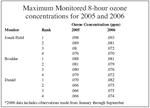|
Pinedale Roundup Volume 104, Number 9 - March 1, 2007 brought to you online by Pinedale Online
Increases in area ozone concentration defy national seasonal trends by Annie O’Brien The BLM’s Pinedale office recently released an Ozone Modeling Analysis Supplement, which details the findings of ozone monitoring at three sites in Sublette County: in the Jonah Field, near Daniel and near Boulder. The analysis was intended to function as an addition to the Draft Supplemental Environmental Impact Statement (dSEIS) for the Pinedale Anticline Decision. The BLM has extended the public comment period for the SEIS, for the second time, until April 6.The previous deadlines were Feb. 13 and March 15. While the supplement did not report ozone concentrations higher than the standard determined by air quality monitoring agencies, it did predict increases in concentrations of atmospheric ozone. Ozone is a “criteria pollutant” according to the National Ambient Air Quality Standards (NAAQS) set by the Environmental Protection Agency (EPA). When found in the upper atmosphere, ozone shields the earth from damaging ultraviolet sunlight. However when it forms near the ground, it can have harmful effects on human respiratory health. Ground levels of ozone are formed by air pollutant “precursors” such as volatile organic compounds (VOCs) and nitrous oxide (NOx) emissions, among other factors. The NAAQS and the Wyoming Ambient Air Quality Standards (WAAQS) establish a standard level of atmospheric ozone concentration of .08 ppm. The BLM and the Wyoming Department of Environmental Quality measured ozone concentration in four eight-hour values over the course of 2005 and 2006. Based on the EPA’s model for measuring atmospheric ozone presence, only after averaging the fourth highest eighthour values over three years can the monitoring agencies determine whether the concentrations surpass the standard. Based on these values for the three Sublette County monitoring sites, the analysis did not show an exceedance of the .08 ppm standard. Nevertheless, the analysis does show elevated ozone levels during 2006 and 2005, primarily in February. Typically, increases in ozone concentrations are observed in urban areas during the summer months because VOCs and NOx forms ozone more easily in higher temperatures and in the presence of sunlight. According to its report, the BLM does not think the winter ozone figures are an anomaly because they were recorded in both February of 2005 and 2006. The BLM’s report lists several hypothetical causes for the heightened winter ozone levels. They include stratospheric ozone intrusion, which occurs when a “fold” allows portions of the stratosphere to enter the atmosphere, according to Darla Potter, a planning section supervisor with the Wyoming Department of Environmental Quality (WDEQ) Air Quality Division. Another potential cause of the increased ozone concentration in the Pinedale area is ozone transport from other areas. Potter said, “long-range ozone transport has been known to happen in other areas.” The analysis also lists “unique meteorological conditions acting upon local scale emissions” and instrument malfunction, as possible causes for the elevated ozone levels. Potter said while the WDEQ had begun an investigation into the causes of the heightened winter ozone concentrations, her agency was anticipating another modeling project, to further document ozone levels. Although the Jonah Field monitoring site and the Boulder site, which is located close to the Pinedale Anticline Project Area (PAPA), showed higher eight-hour ozone concentrations than the Daniel site (please see chart), Potter said the WDEQ lacked sufficient information to attribute the elevated levels to increased traffic and industrial activity near those areas, due to oil and gas development. “We do not have the ability at this point in time to attribute [the causes of the higher levels of ozone] to a specific category of sources,” she stated. Because of the unexplained winter ozone increases, the BLM advises all operators to utilize techniques that would limit NOx and VOC emissions. It recommends using liquid gathering systems, centralizing gathering facilities, reducing truck traffic and lists “proposed revisions to strengthen WDEQ-AQD oil and gas permitting guidance.” Ken Peacock, of the Wyoming State Office Planning and NEPA division of the BLM, said ground level winter ozone “is a new phenomenon in the rural west.” There is little precedent of monitoring ozone concentration in these areas, which makes it difficult to assess the results of the analysis. “The trouble with any of these rural values is that they didn’t have monitors. They didn’t even know it was a problem,” Peacock said. He insisted the model was designed to err on the side of caution in predicting future ozone concentration levels, and the BLM would comply with any mitigation actions See The Archives for past articles. Copyright © 2007 Pinedale Roundup All rights reserved. Reproduction by any means must have permission of the Publisher. Pinedale Roundup, PO Box 100, Pinedale, WY 82941 Phone 307-367-2123 editor@pinedaleroundup.com |

